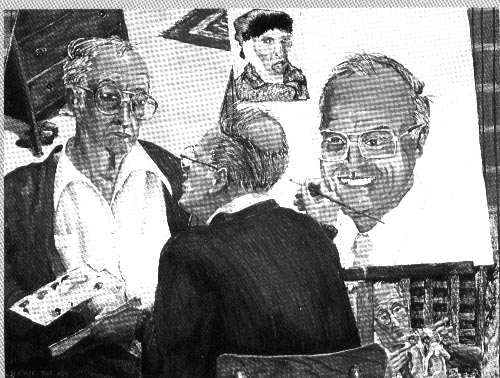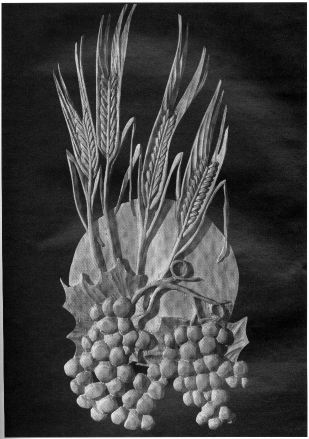

The phone rings and quickly, the caller is greeted by a voice that carries more than a trace of its Dutch roots. Music plays in the background.
"You caught me working on my latest project," said Fr. Herman Falke, SCJ, talking from his art studio in Ottawa.
It soon becomes apparent that there is rarely a time in which one would not catch Fr. Herman working on one of his projects, or doing parish ministry (he is currently pastor of two parishes) or teaching. Of course, he is retired, so his schedule is lighter than it was a few years ago when it also included serving as a teacher and chaplain at a Catholic high school.
At 70, Fr. Herman continues to do what he has been for most of his years of ministry: a little bit of everything. Originally from Holland, he came to Canada in 1952 as a seminarian. He was ordained in 1954.
Art has been an important part of his life for as long as Fr. Herman can remember. One of his early superiors even suggested that he study art full-time. But he wasn't interested in devoting all of his energies to a singular passion. "I've felt a dual call," he said. "It's a beautiful combination to be an artist-pastor, artist-teacher." His ministries often fuel and inspire his art. "For me it has always been best not to devote myself to art alone; the other things, my ministries, expand who I am and what I can create."
Nowhere was this more evident than when he went to Uganda in 1966. A volunteer of the Canadian government in a program similar to the United States' Peace Corps, Fr. Herman taught art and served as a chaplain at a Catholic college for six years.
"Immersion in this African milieu changed my Western way of evaluating
and creatively recording life," he said. "It taught me to be open to another
culture and not simply stampede in with a Western style of art."
 |
 |
In fact, he credits his experience in Uganda for a renewal in his art. It was a the start of a "creative spurt... that has been carried on in Canada to the present time," he wrote in Spirit and Life in Sculpture, a book published last year by Fr. Herman. In it are photographs representing his pieces in sculpture and paint during the past 30 years. Many of the photographs were taken by the resident photographer of the National Art Gallery in Canada.
The book includes several colorful paintings, mainly from his years in Africa. However, it is sculpture which Fr. Herman prefers. He uses a variety of mediums, including wood and ceramics, and said that it is the challenge that draws him to sculpture. "I can do a painting in a few days but a sculpture can take weeks to complete," he said. "It is more physically demanding and challenging than painting."
Many of his sculptures and woodcarvings have been commissioned by others. In the last ten years, he has done seven sets of the Stations of the Cross. "That is a very intense project," he said, adding that he spent at least 5,000 hours producing the seven sets. "There are 14 pieces which all need to be different but also organic. I think that I have improved with each set but it is still very intense work."
One of his favorite pieces of his own art is from one of these sets &endash;&endash; the "Agony in the Garden; Station Two." "I thought it was a good depiction of the Christ figure," he said.
Most of the sets were done for Toronto-area churches.
He has also been commissioned to do works for schools. "Several times I was contacted after a student had died tragically," he said. "The school wants to create some type of memorial and they ask me to help."
Last year, St. Paul University in Ottawa commissioned Fr. Herman to create a 98" x 33" woodcarving in commemoration of its 150th anniversary. The work was unveiled during the kick-off to the anniversary celebrations last fall.
He has done a wide-variety of art but many of his favorites involve depictions of people, especially their interactions with each other. "I just have fun with that," he said.
With age comes the comfort of being able to do what he wants in art. Unlike a young "struggling artist," Fr. Herman said that he is lucky enough to be "outside of the market. I have a pension; I do not need to sell my work to feed myself. So, I am free to challenge people. I can be independent." The younger artist does not always have this freedom.
Was there ever a time when he did "bow to the market?"
"Oh yes," he said. "But that was years ago. I am free to do what I want now."
He loves his art but he also loves sharing the joy of his craft with others. For years he did so as a teacher on the high school and college level. But it has not always been behind the walls of a conventional classroom that he has shared his knowledge. When he served as pastor of St. Joan of Arc parish in Toronto, he taught adult art classes in the rectory, "and sometimes even in the sacristy." He encouraged his parishioners to join him but welcomed people of all faiths in his parish classroom.
In Toronto, Fr. Herman also organized yearly art shows with a religious theme, such as the Old Testament or "spiritual women." Area artists would be invited to submit a work which addressed the year's theme.
As for himself, Fr. Herman has done several of his own shows, both alone and in collaboration with other artists. This year, he will be doing one at the SCJs' Wasdeda Gallery in Baileys Harbor, Wis.
Fr. Herman works on his latest projects in a studio based in the SCJs' community house in Ottawa. The caller apologizes for interrupting work on his latest piece, a carving based on Mt. Rushmore. "Oh, don't worry about it," the artist said lightly. "That piece of wood isn't going anywhere."
It's the relaxed response of someone who enjoys the lighter days of retirement and capturing the world on his own timetable.
